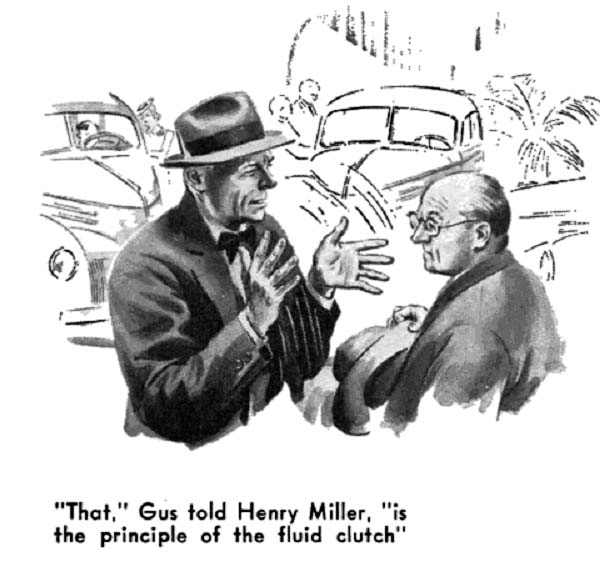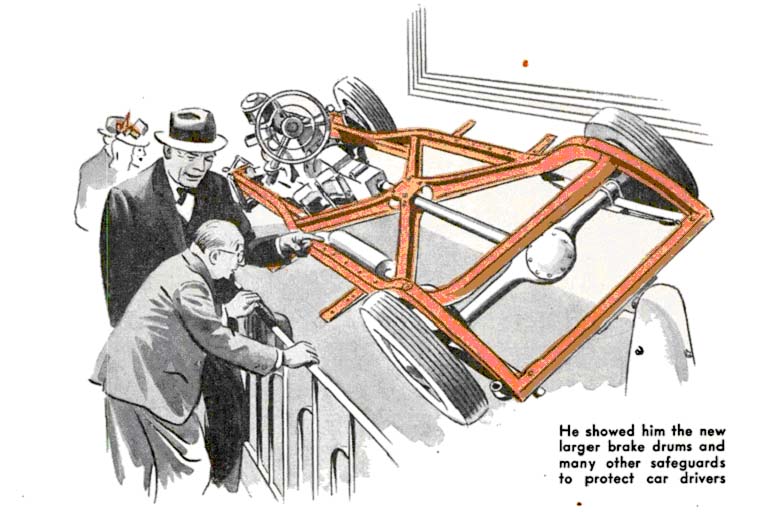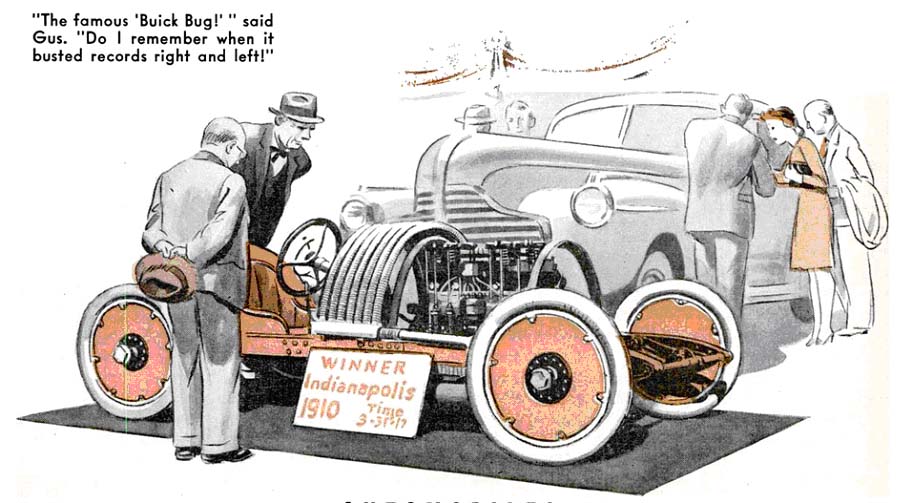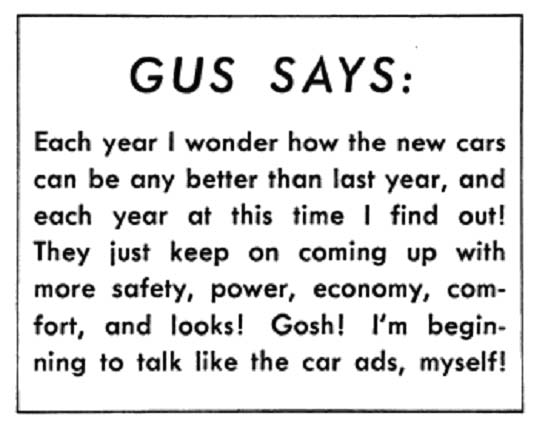November 1940
GUS AND JOE GO TO THE SHOW
by Martin Bunn
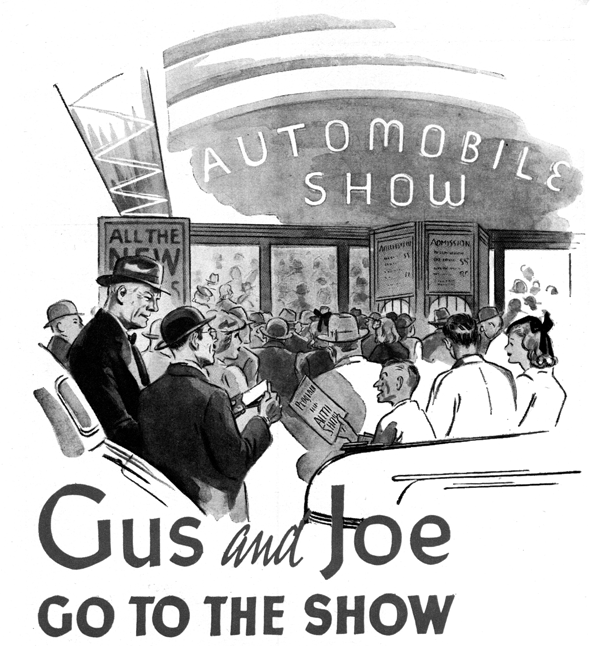
"By Gum, you're all starry-eyed!" Joe Clark said to his Model Garage partner Gus Wilson as they started up the broad stairway of Grand Central Palace.
"Sure I am!" Gus admitted without shame. "This New York Automobile Show always gives me a thrill, and I've been coming to it for a flock of years. I remember my first show as plainly as if it had been yesterday -- and it must have been thirty-five years ago. They held it in Madison Square Garden in those days -- the old Garden. Cadillacs and Oldsmobiles and White Steamers and Autocars -- those old-timers look funny when they dig them out now, but they were hot stuff then. But it was an exhibit up in the balcony that interested me most -- a racing car called the '999'.
There was a thin-faced, quiet-spoken sort of fellow standing by it in the booth, and somehow we got to talking. He told me that his name was Henry Ford and that he had built the car and driven it at better than sixty miles an hour on the ice out near Detroit. That was a thrill -- talking to a fellow who had driven a mile a minute! But I got a bigger thrill when I got back on the main floor and a girl came along, all dressed up to kill, and happened to give me a look out of the darndest green eyes I'd every seen -- and that goes for now, too. It sort of took my breath away, and no wonder -- I heard a fellow behind me say: "That was Anna Held who just passed us. Now, Joe, don't tell me you don't know who Anna Held was!"
"Yes, I know who Anna Held was," Joe assured him. "She was long before my time, but I saw a movie all about her a few years ago. It was one of those historical movies," he added unkindly. "I suppose it was the remembrance of that one look she gave you with her green eyes back around 1905 that kept you from ever getting married!"
"Well, I wouldn't go quite that far," Gus told him. "But I was young then -- "
"Sure -- you were young then" Joe parroted. "And now whenever you get close to a few new-style gas-buggies you go downright childish. I'll bet a quarter you'll come out of here talking about buying yourself a new car. Well, I won't -- mine's good for another two or three years . . . "
Gus grinned wisely as he handed over their tickets, and they started into the big exhibition hall. "Let's start by having a look -- "he began and as interrupted by a feminine voice.
"Yoo-hoo! Yoo-hoo! Oh, Mr. Wilson!" He looked in the direction of the hail and saw the talkative Mrs. Miller and her husband, Henry.
"Oh, my gosh!" Gus muttered. "Why did it have to be her?"
"We'll have to talk to them," Joe urged. We've got to be polite -- they're darned good customers."
Mrs. Miller didn't wait for them to make a move. She skipped over to them, talking as she came.
"Oh, this just wonderful!" she babbled. "You're the people I most wanted to see here! I've been coaxing Henry to buy us a new car, and at last he has recapitulated -- capitulated, I mean. Now you and Mr. Clark can help us pick out the one we should get."
"I said 'maybe,'" her husband hedged glumly.
"'Maybe' always means 'yes,'" Mrs. Miller said archly. "I'm sure it would save us money in the long run."
"What sort of car are you people thinking of getting?" Gus put in to forestall an argument.
"I just saw one I'd love to have," Mrs. Miller said. "Henry hasn't seen it yet. Come on -- let's all go and look at it."
She led the way down an aisle lined with sleek 1941 cars, and Gus's quick and experienced eye noted that nearly all of them looked longer, wider, and lower than the 1940 models, that many of them were more definitely streamline, that two-tone finishes were frequent, and that bumpers were more massive than any he'd seen before. But just as he was about to become vocal about some of his observations, Mrs. Miller brought up in front of a Super Eight Custom "180" Packard and announced brightly, "This is the one."
Gus looked at the big beauty. Then he looked at Henry and grinned. "That's quite a lot of automobile, Mrs. Miller," he said. "It looks longer than last year's model," he added to the salesman.
"The wheelbases of all our models are the same as they were last year," the salesman told him, "but the over-all lengths have been increased by five or six inches, and the hoods are two and a half inches longer."
"What I especially like about this particular car," Mrs. Miller announced importantly, "are the really wonderful improvements you can have on it. This gentleman told me about some of them -- mechanical refrigeration and air conditioning, for example. Just think, on the warmest day -"
That's a wonderful stunt," Gus agreed, "but it's fairly expensive, isn't it?"
The salesman pressed a button on one of the doors and the open window above it closed smoothly. He pressed another button and a glass partition slid noiselessly into place between the driver's and passengers' compartments. "Power operated," he announced proudly.
"That's a new one on me," Gus admitted. "Where's the gadget that runs it -- under the front seat?" He examined the unit interestedly and nodded. "I see -- a reversible electric motor hooked up to a hydraulic pump with a reservoir tank, and a hydraulic cylinder for each window. Mighty clever!"
The salesman realized that he was talking to a man who knew his automobiles.
"We have a number of improvements this year which I seldom mention to the ladies -- so few of them are interested in such things," he said. "New connecting-rod bearings. And a new pressure cooling system. It operates at four and a half pounds above the atmospheric pressure on the low-price '110' and the '120' models, and at seven and a half pounds above on Super models, and raises the boiling point of the cooling liquid so as to permit warmer engine temperatures at all altitudes."
"That's interesting," Gus said. "I'd like -- "
But the conversation had become too technical for Mrs. Miller. "I think we'd better look all around before we decide on anything," she told the salesman. "Thank you so much."
"Some one," Mr. Miller said, "was telling me about a car -- I don't remember which make he said it was -- that hasn't got any gears to shift. That doesn't seem possible to me, but if there were such a car it might be a good one for my wife to drive. She's always getting stalled shifting gears, and you know how she chips transmission teeth!"
"You're thinking about cars which have what they call the liquid clutch," Gus said. "There are several of them. There's the Oldsmobile exhibit over there. Let's have a look at their Hydra-Matic Drive -- it's mighty interesting. But, say -- we've lost your wife and Joe."
"Oh, they'll be all right -- run into them somewhere," Henry said with more than a touch of relief in his tone. "I want to take a look at this new stunt you're talking about."
"It isn't altogether new," Gus explained. "The Oldsmobile people are continuing it from last year, as optional extra-cost equipment. Know how it works?"
"Nope," Henry admitted. "I guess I'm still just a Sunday driver who doesn't know a thing about cars."
"Well," Gus said, "you sell electric fans in your hardware store, so you know something about them. Now, suppose you hooked one fan up to a wall plug, placed another fan, not hooked up, facing it and about an inch away, and then switched on the fan you had hooked up. What would the other fan do -- the free one?"
"It would turn, too."
"Right!" Gus said. "In other words, the power would be transmitted from the driven fan to the free fan through the air. Well, that's the principle of the fluid clutch. But it's worked out in the form of a liquid coupling in which oil takes the place of air. Two rotors are placed in a case filled with oil. One of them is driven by the engine. It transmits the power through the oil to the other rotor, which drives the car's wheels. In the Hydra-Matic drive the liquid coupling is used in connection with an automatic-transmission assembly. There's no clutch pedal, and no gearshift. Instead there's an automatic control just below the steering wheel. It has four positions -- neutral for parking, high for normal driving, low for steep hills and heavy going, and reverse for backing. After you flip the lever into high you don't have to move it for normal driving -- you step on the gas pedal when you want to go, and step on the brake pedal when you want to stop.
"Well, here are the Oldsmobiles -- three sixes and three eights, varying in size and price, but all mighty pert and modern looking. Built-in running boards which are exposed only when the doors are opened. Sealed-beam headlamps -- they make night driving safer. One-piece hood -- when when you lift it you can get at any place in the engine compartment without being a contortionist. And Hydra-Matic Drive, if you want to pay extra for it. Lots of interesting features."
Henry Miller shook his head in admiration. "You're a wonder, Gus," he said. "You just take one look at these new cars, and you know all about them."
"I'll let you in on something," Gus confided. "This is my second trip to the show today. I came down to town early, and when I met Joe for dinner I told him I'd gone to a movie to kill time after I'd finished my errands. Don't let on to him, or he'll never stop kidding me about it -- he thinks I'm a nut on cars, and I guess he's right! That reminds me, there's one I missed this afternoon that I want especially to see -- that new Nash '600' they brought out to compete with Chevrolet, Ford, Plymouth, and Studebaker in the low-price field. I met an old friend of mine who's a big shot with the Nash people now, and he told me that they'd spent three years developing and road-testing it, and seven million dollars getting it into production. Let's go and have a look at it.
"Here's their exhibit," Gus said a minute or so later. "And there's the new '600' -- it's a classy-looking bus, isn't it, with its torpedo-type body and two-tone finish. It's a good-size car, too -- 194 inches over all, George told me, with full three-passenger seats. He said that it's built like a bridge -- that the body and frame are a single welded unit, light, but twist and rattleproof. Another new feature is the spring suspension -- coil springs on all four wheels, in tubes and integral with the shock absorbers -- it's a European idea. The car has a six-cylinder engine with the manifolds sealed into the block, and they claim that an average good driver can get between twenty-five and thirty miles out of a gallon of gas. Those other Nash cars are the Aeropowered Ambassador Six and the Aeropowered Ambassador Eight. They're in the low-medium and upper-medium price groups, and they both have twin-ignition, valve-in-head engines -- they both have claim it's the nearest thing to an airplane power plant that you can get in an automobile."
"You say this Nash '600' was brought out to compete with some other cars. Well, let's go and look at those other cars," Henry suggested.
Gus grinned at him. "You're getting the show bug!" he said.
"All right -- I'm with you as long as my dogs hold out. Here's the Studebaker exhibit. Their Champion is in the low-price group. They've upped the horsepower of its six-cylinder L-head engine to eighty by making some changes in the cylinder head and the spark plugs. The car's longer and wider than last year's model, but by cutting down dead weight they've kept it under 2,500 pounds. Notice that there aren't any running boards? Those larger cars are the Commodore and President lines. You can get the new slipstream Land Cruiser model in either. Well, we'd better be getting along, Henry. There's a lot more to see in this show."
They got along. Gus halted shortly to talk with one of the Plymouth salesmen.
"How'd Plymouth step its motor up to eighty-seven horsepower?" he queried.
"New camshaft lifters," was the prompt reply. "They raise the intake valves quicker and farther, letting more gas and air enter the cylinders with a rush. There's a new intake manifold, too, that distributes the vapor better to al cylinders. They've added new bearings with five times the life of the old ones. And that's not all. That added power is multiplied still further with new rear-axle ratios that give better getaway and pick-up. And a higher gear ratio in second speed lets you use it for most of your starting, without bothering with low, unless you get in a snowdrift or mud. If customers want it, they can have a Power-matic gearshift that uses vacuum to do most of the work. In addition there's a new oil cleaner and air filter . . . "
"Hey Gus," Henry managed to get in. "Our time's getting short."
Thanking the salesman they moved on to Chevrolet and Ford, admiring each in turn. Both featured a host of new mechanical, accessory, and design improvements besides carrying over from last year such advanced ideas as steering-column gearshift and sealed-beam headlights, with Chevrolet again featuring the vacuum power shift and larger Tiptoe-Matic clutch. Ford, Mercury, Lincoln-Zephyr, and Lincoln -- all newcomers to the Auto Show this year -- were gone over from bumper to bumper by Gus's appraising and approving eye.
Moving on, they examined the smart torpedo-bodied Pontiacs. Henry was enthusiastic over their big, comfortable bodies, and Gus over their precipitation-type oil cleaners and new-design safety steering wheels. They looked at the Grahams -- especially at the new Hollywood Custom model, a long, racy-looking car with a body wider than it is high, and its floor only twelve inches from the pavement.
Then they looked at the Chryslers -- longer, wider and lower than the 1940 models. "They all have fluid drive -- it's standard equipment on all eights and on one Windsor model. It's optional on the other Windsors and the Royal," Gus said. "It's the same fundamental idea as the Hydra-Matic Drive, but it's worked out differently. Chryslers have conventional transmission assemblies and clutch pedals, but under average driving conditions you can shift into high at the start of a long trip and stay there the rest of the way. On these '41 cars they've combined fluid drive with automatic safety control which suits the gear ratio to every normal driving condition, keeps the car under positive control, and automatically protects the driver on hills, in traffic, and on snowy or slippery roads."
"That fluid-drive idea sounds like a mighty good thing to me," Henry said. "Did you say that some other cars have it?"
"Yes," Gus told him as they approached the DeSotos. "To name a couple more, DeSoto and Dodge. And on DeSoto it comes with a new transmission. But DeSoto is also available, if you wish, with a regular transmission to which a vacuum-type gearshift booster can be added.
"Those new safety rims on most of the Chrysler line keep you from throwing a tire when you have a blow-out, and they're said to make a flat tire ride as though it still had ten pounds of air," Gus declared.
"Say! We can't afford to miss these Hudsons," he added. "Look at the Six and the Six Traveler -- 116-inch wheelbases, engines which have been upped to ninety-two horsepower by increasing their compression. Symphonic Styling which assures the ladies a harmony of exterior and interior colors, and don't forget that goes for the low-price group! Then there are the Super-Sixes and Commodores -- larger and more expensive. Lots of improvements on all of them -- a cowl ventilator which you can leave open during the heaviest rain storm; larger brake drums; and new clutch-pedal mechanism which requires only three quarters as much effort to operate as the old one did."
Gus pulled out his watch. "Holy Moses!" he exclaimed. "Only a half hour to closing time, and you haven't even seen the new Buicks!"
Wide, low bodies, dashingly streamline, were the Buick features which first caught Henry's eye. "Yes they look good," Gus agreed with him. "But there are a lot of just as important improvements which don't show on the outside. Increased power, for one. One of the reasons for that increase is an improved bearing -- it took the Buick engineers five years to develop exactly what they wanted, but they've got it now. Then there's compound dual carburetion. That's something brand new. It costs a little extra on the Series 40 engines, but is standard on the larger ones. By using two dual -- double-barrel -- carburetors instead of one, better mixture ratios of air to gasoline are fed to the engine, power is increased, acceleration and hill-climbing improved, and fuel consumption cut down. Another new feature is the method of forcing fresh air to the carburetors with an air scoop set up in the radiator grille. The air is piped to the air cleaner above the carburetors and it's actually under pressure from the car's forward motion!
"There's another thing. To squeeze the most power out of the gasoline, they've redesigned the piston heads so the mixture in each cylinder is compressed into a tiny ball right around the spark plug. When the spark ignites it, they get the maximum pick-up and power from the explosion, without any ping or detonation -- knock to you.
"Say, here's something," Gus broke off suddenly, to the relief of Miller whose brain was beginning to knock a little itself under the high compression of Gus's explanations. "The 'Buick Bug!' Famous old racing car! Brother, do I remember back in 1910 when Louis Chevrolet was busting speed records right and left with it! Look at that radiator -- behind the motor. Just a bunch of curved pipes with fins on them.
It didn't even have a fan then. Notice that Buick had overhead valves then -- and has stuck to them ever since."
"Like Chevrolet," interrupted Miller. "They still have overhead-type valves, too, haven't they?"
"Right," answered Gus.
Passing the Chevrolet display again, Gus remarked, "They've redesigned the combustion chamber this year so the new Chevrolets will turn up ninety horsepower instead of eighty-five. And the wheelbase is increased to 116 inches to give you a steadier, smoother ride . . ."
"Yoo-hoo! Henry! Mr. Wilson!" Mrs. Miller's voice was calling from across the aisle.
They went over to her and Joe, feeling properly ashamed of themselves for having played truant for so long. But Mrs. Miller didn't seem to care, and Joe Clark was looking both self-satisfied and faintly embarrassed.
"I've decided which car we want, Henry," Mrs. Miller told her husband. "Mr. Clark advised me about it, so you needn't worry. The salesman is going to bring it out for you to see next Sunday morning. And what do you think Mr. Clark has done?"
Gus looked hard at his partner, and Joe got red in the face.
"He's either robbed a bank and got away with it, or he's bought a new car," Gus said.
"Well, my old bus is worn out -- you said so yourself," Joe defended himself rather sheepishly. "I'll bet you bought one yourself -- it was you who wanted to come to the show."
"I didn't buy anything except my ticket to get in," Gus said cheerfully. "I like all these new gas-buggies too much to settle down to any one of them!"
"Isn't that just like a man?" Mrs. Miller demanded. Then she giggled. "Mr. Wilson, I'll just bet that you felt the same way about girls, and that's why you never got married!"
END
L. Osbone 2019
